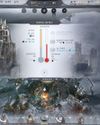
Huddled alone in a corner near bombsite A, I knew I didn’t have a chance of sneaking in and planting the package strapped to my back. The defense had just wiped out the other four members of my team, and they knew the bomb was close. They’d be waiting to dome me as soon as I stepped around a corner. So instead I activated my ult, an ability I’d been charging up for half a dozen rounds. After a tense, vulnerable few seconds, I teleported clear across the map to bombsite B and armed the bomb, adrenaline pumping at the thought of pulling off a 1v4 upset.
“Unloseable!” says League of Legends shoutcaster David ‘Phreak’ Turley, who was helping my team of journalists learn the basics of Valorant, Riot’s new competitive shooter. Unloseable for him, maybe. It was meant to be encouraging, but unfortunately, Turley underestimated my ability to choke under pressure. The defence raced to my bomb site and I fumbled my other remaining abilities, throwing down smoke clouds that blinded me as much as they did them. Instead of hiding to scare off an attempted disarm, I went in—and down—guns blazing. They had just enough time to defuse my unloseable victory.
I’m still mad I blew my chance at glory, but the thrill of that moment has stuck with me. It showed how dramatically a well-timed ability in Valorant can alter a match, and made me think ‘OK, maybe Riot has something here’. Because at first, I wasn’t so sure. Hero abilities allow for clever strategies and exciting upsets, but look past them, and Riot Games has fundamentally spent the last five years building Counter-Strike.
TEAMFIGHT TACTICAL
This story is from the {{IssueName}} edition of {{MagazineName}}.
Start your 7-day Magzter GOLD free trial to access thousands of curated premium stories, and 9,000+ magazines and newspapers.
Already a subscriber ? Sign In
This story is from the {{IssueName}} edition of {{MagazineName}}.
Start your 7-day Magzter GOLD free trial to access thousands of curated premium stories, and 9,000+ magazines and newspapers.
Already a subscriber? Sign In

"The War Within itself has kept me coming back most evenings too"
WORLD OF WARCRAFT remains my jailer, and I couldn't be more pleased about it

OK BUILDER
SATISFACTORY is the new titan in building and crafting games

HELL YES
DIABLO IV: VESSEL OF HATRED is a transformative expansion

MOUSE: PI FOR HIRE
This mouse wants to be more than just a gimmick

WINDBLOWN
Dead Cells dev's new roguelike has me afraid for my free time

NO MORE ROOM IN HELL 2
As the zombie horde surrounded me just moments after taking down my two remaining teammates, the writing was really on the wall. Armed with just a chef's knife, it was clear I stood no chance, but I was going down swinging, hoping for a miracle... it didn't come.

OWNED BY STEAM
VALVE cordially reminds you that your games aren't yours

CURSE OF THE AZURE BONDS
These classic games haven't aged badly, but I sure have.

DEEP FREEZE
Endure a blizzard of tough choices and rough consequences in FROSTPUNK 2

NEW HORIZONS
Building up REMNANT 2 outside the live service game grinder